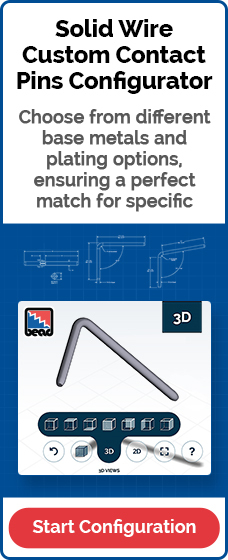Since Americans can produce around 2.3 million tons of metal waste in a single year, it's important that we do all we can to reduce our carbon footprint. Metalworking processes should be altered for sustainable manufacturing to minimize the amount of waste output.
With common processes like swaging, it's especially important that you invest in environmentally friendly processes. Read on to learn how you can reduce waste through sustainable manufacturing practices.

An Introduction to Swaging
Swaging is a cold-forming process that moves metal, differentiating it from other metal fabrication processes like machining or stamping, which create a shape by removing material. A scrapless process, swaging is an essential part of metalworking, altering the sizes of rods or tubes, whether they're solid or hollow. This process begins when a metalworker (or metalworking machinery) inserts the tube within a die.
The die then hammers onto the tube's radius and decreases its diameter methodically. Some dies also expand on this technique by applying these compressive forces to modify the tube's shape in other ways.
As the tube's diameter is decreased the material is compressed inward. The amount of material will remain the same at any vertical cross-section of the part. The result of this "constant volume" at the cross-section is a limit to how far any given diameter can be compressed before you reach what's called "virtual solid."
Applications of Swaging
Since tubes resulting from swaging are used in a wide range of industries, the process is common. Swaging processes control metal output in the automotive, PCB, telecom, machine manufacturing, construction, and architectural industries (just to name a few). But tubes aren't the only thing that the swaging process is used to create. Pins are one of the more common applications of swaging.
You can create solid wire pins with consistent lengths, retention features, collars, and other configurations. You also can have hollow pins made at an even lower cost if you don't need a pin that holds too much weight for them. Sustainability within this one section of the metal production industry can save a lot of waste.
Therefore, innovative solutions that address these two core pain points of most manufacturers—scrap production and energy output—are essential. Fortunately, experts have developed methods to save both the environment and your money.

Scrapless and Sustainable
Unlike the usual die-rolling, four-slide forming, deep drawing, and progressive stamping methods of metal forming, our method of swaging leverages a simple, individualistic cold-forming process. A single metal strip is pulled continuously through a precision-engineered draw die. This in turn creates a tube that can be formed into various customizable shapes.
The creation of these custom shapes is achieved by reducing the diameter of the tube, moving metal each time the part advances through the forming die. The end result is a tube that was manipulated rather than being cut up and hollowed out with waste-producing dies.
This approach to swaging is essentially scrapless, allowing us to move metal rather than remove it. If we begin with 100 pounds of metal coil, we conclude with 100 pounds of finished metal parts. This is because none of the metal is removed from the original coil, it’s simply reformed into new shapes.
Environmental Impacts of Swaging
There are therefore many environmental impacts of sustainable manufacturing.
First, investing in these practices (or parts made with these practices) allows you to do your part in reducing scrap and emissions. You, therefore, protect the environment and ensure that you do your part in supporting sustainable manufacturing methods.
You also ultimately get cheaper products. Since going green and engaging in sustainable development uses both fewer materials and less electricity, you won't need to pay as much for pins. Since many people purchase these parts in bulk, you can save hundreds (or thousands) on your next project.
Environmentally-Friendly Manufacturing
While swaging itself generally isn't considered an environmentally friendly process, it is the market leader in sustainability compared to other metal fabrication processes. In addition to leveraging swaging in many unique part solutions, Bead is always looking for new or additional ways to minimize its carbon footprint. If you're purchasing pins or other cylindrical metal objects, this is essential, especially if you plan to buy in bulk.
Now that you know why Bead's values of sustainability can assist you in going green, it's time to get started. Request a quote, submit a concept, or schedule a design review with the Bead team today to learn more about logistics and pricing for your specific project.
Bead Electronics can also use swaging to help you make custom contact pins and end-to-end pins. Our experts work to ensure that these pins are not only durable but also meet your individual applications. If you need metal pins of a precise size to help you hold your projects together, this is a great choice.
About Bead Electronics
Bead Electronics, is a global manufacturer of electronic connector pins and has been manufacturing in Connecticut for over 100 years. The award-winning company carries over 500 patents and is best known for inventing its manufacturing process called swaging. This process is a high-speed, virtually scrap-less, cold-forming process capable of producing a wide size range of metal electronic components that are consistent and cost-effective. The family-owned business is led by its fifth generation. Click here to speak to a connector pin specialist today.



